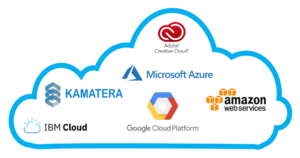
How to Select the Right Cloud Platform for 2021
7th June, 2021
The quest for the cloud is going to loom higher than ever in the aftermath of the Covid 19 crisis. According to Gartner, cloud services are going to make up for 14.2% of the entire global IT spending market by 2024. It is only natural that most businesses will begin to focus on cloud platforms to nurture and grow their businesses in the post-pandemic scenario. But since there are so many options around, it is only natural that there will be lots of uncertainties borne out of unfamiliarity.
Identifying the need
Cloud platforms cater to various needs and requirements, depending on who their client is. Some people look for cloud providers who can manage their files on a personal level, some for a company-wide application spanning the entire networks, and some only a portion of their business. Now, here are some basic things to consider before focusing on a partner:
Security
Obviously security of data is the first thing to consider. If you are managing a client’s privacy or confidential documents within a cloud network, think of the scandals and negative publicity it would invoke, especially if it finds its way to hackers. So while vetting a cloud provider, make sure they are completely verified and have proper compliance standards. It would also be wise to check into their records, and confer with previous clients to know how they handled and monitored the security of their networks.
A credible cloud provider should be able to identify the security breaches, plug the holes, and protect the client’s privacy and confidentiality at any cost. The security precautions must not just include the data that’s in the cloud, but should include data that’s in transit. The transit time could be minimal, but the security encryption should be so accurate that they remain safe.
Disaster Recovery
Every company’s survival hinges on their ability to recover from disasters. There could be natural disasters that could wipe out physical evidence and paper documents and even servers and networks, but cloud data is virtual data, and permanent harm can be prevented if the vendor is careful.
Discuss with the cloud vendor what methods they have in case of disasters, and what processes they perform for conducting integrity checks, data backups etc. Know what the vendor covers and doesn’t cover in data recovery. Cover the steps the vendor explains because nothing can be worse than finding out the vendor missed out on a crucial process in data recovery than when you are really in the process of data recovery. Go through their processes with a fine tooth comb and if satisfied with their data restoration methods, the vendor could be considered.
Handling of downtimes
How good is the cloud vendor in handling the downtimes? The reliability of the vendor in managing planned and unplanned downtimes go a long way in deciding their capability. Discuss this factor long and hard with the vendor, and request them to show their metrics in handling all kinds of downtimes. If they don’t respond in the affirmative or put off showing those metrics, that should raise some red flags in you.
Moving to the cloud? Here’s what you need to know
This is perhaps the first and foremost thing that you must do. Depending on what your requirement is, the vendor will be able to share their features and services. This would help you shortlist your requirements, and choose from vendor packages.
1.Check the near-term application goals of your business
It is often not easy to enjoy the full benefits of moving to the cloud, until there is a cloud-native architecture procured through PaaS or Platform as a service. But that can also be a tough move as it could depend on your transformation requirements and the complexity of those applications.
A certain amount of refactoring would be required to reap the full potential of cloud services. To ensure there is success during migration, ensure you embrace a phased approach. This is more important if your business’s enterprise applications were not built on the public cloud. Could be a time-taking move, but definitely worth the effort. Consider which applications need to be modernised first, and which can be continued on-premises or in the public cloud. This can help in a successful and low risk migration. Considering these points would help you create a clearer roadmap while transitioning to the cloud.
2. Technology advancements
A cloud vendor with the latest technological advancements is advantageous, but make sure what they offer is compatible with your business needs, workloads and cloud objectives. Your company must also have a technically adept team to manage the transition.
Find out how much re-coding or customization, you may have to do align your workloads with their platforms. Also find out if the service provider offers comprehensive migration services and support and help as part of their technical staff during the assessment and planning stages.
3. Support and help
Ensure the vendor is able to provide assistance and support 24/7. With huge amounts of data in the cloud, companies cannot afford to do business with someone who isn’t available. Also, check the support they provide during migration and deployment.
4. Certifications & Standards
Following the industry’s best standards and adhering to the global mandates are so important. So while shortlisting potential vendors, make sure the vendor complex with all of these strictly, and to the letter.
It is important that companies understand the cloud agreements, because they can appear really complex and jargon heavy. Some cloud vendors even take pride in featuring jargon heavy, complicated SLA (Service level agreements) There could be general out of the box terms and conditions to individually negotiated contracts and SLAs. Make sure the vendor will be able to support the individual conditions; it is also wise to ask them about the plans they have in fulfilling their contracts.
As the first step in moving to the cloud, you can first analyze your business requirements and send out feelers for getting connected with potential cloud vendors. After thoroughly vetting and monitoring them, you can go through your checklist of requirements, and make the vendors’ list short. Armed with knowledge on their working scenario, data security, compliance, data transition processes, data governance and service management requirements, have a detailed one-to-one with them on the configuration needs and specific environments before selecting the right vendor.
5. Vendor should be transparent about data center locations
Companies usually have a data classification scheme where they define the different types of data, as per their sensitivity, location or government policies. It is important that every business be aware of the government policies regarding personal data, and while moving to the cloud, should note the location where the data will be stored.
There might be local laws that these businesses have to cater to, so while choosing the cloud vendor, this is something they have to adhere to. If there are sensitive volumes of data, that must be encrypted, with access limited to approved administrators only.
6. Choosing multiple vendors
It is important to analyze the service dependencies and partnerships the cloud vendor has that can turn complementary and supportive during transitioning and migration. For example, if you are looking at a SaaS CRM, what are the existing financing and marketing services integrations that they have. If they support multi-vendor environments, ask them to show examples for the same. Analyzing their accreditation levels and technical adeptness could also be worthwhile. Think long and hard before signing the contract, especially when there is a long line of subcontractors involved, especially with mission-critical data.
7. The Budget
A really reliable cloud vendor with foolproof plans could be expensive. But that’s not any rule of the thumb thing. There can be vendors who can provide exactly what you need at budget rates. Before opting for any of the cloud vendors, check their plans, compare them with your infrastructure, and see if they both match. If not, exit.
Here are the most popular cloud service providers that you can consider:
- Amazon Web Services
- Google Cloud Platform
- Microsoft Azure
- Server Space
- IBM Cloud Services
- VMware
- Kamatera
- Adobe Creative Cloud
Conclusion
As the first step in moving to the cloud, you can first analyze your business requirements and send out feelers for getting connected with potential cloud vendors. After thoroughly vetting and monitoring them, you can go through your checklist of requirements, and make the vendors’ list short. Armed with knowledge on their working scenario, data security, compliance, data transition processes, data governance and service management requirements, have a detailed one-to-one with them on the configuration needs, specific environments before selecting the right vendor.
While choosing the best cloud service provider, ensure they are agile enough to adapt to your business goals. So when you have a good plan, then can easily adapt to it, provided they have your well-defined implementation milestones and clear-cut business objectives. Moving to the cloud is not an option anymore. More fearlessly, experiment confidently and grow in business.




